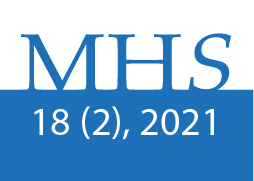Energy Expenditure and Intensity of Cheerleading Training: A Descriptive Study
DOI:
https://doi.org/10.15359/mhs.18-2.8Keywords:
physical exercise, athletes, performanceAbstract
The objective of the present study was to answer the following questions: are the energy expenditure equivalent in terms of METs of cheerleading training sessions and what Ainsworth et al. (2011) show? Are there statistically significant differences in the energy expenditure and intensity of cheerleading training when comparing different performance and sex categories?
Methodology: Energy expenditure and intensity were measured during one hour of cheerleading training for a sample of 103 cheerleaders (men = 55; women = 48), who belong to three all-star teams and two national teams from Costa Rica.
Results: No differences were found between the value reported by Ainsworth et al. (2011) and cheerleading workouts (6 METs vs. 5.8 METs, t = -1.7, p = 0.092). A significant interaction of energy expenditure (kcal) between sex and performance category was evident.
Conclusions: The energy expenditure in terms of METs for cheerleading workouts is equivalent to that reported by Ainsworth et al. (2011). Men with a “high” performance category had significantly higher energy expenditure (p <0.05 *) compared to men with a “medium” or “low” category and with women in all three categories. No differences were found in terms of intensity when comparing sex and performance category.
References
Ainsworth, B. E., Haskell, W. L., Herrmann, S. D., Meckes, N., Bassett, D. R., Tudor-Locke, C., Greer, J. L., Vezina, J., Whitt-Glover, M. C. & Leon, A. S. (2011). 2011 Compendium of Physical Activities: A second update of codes and MET values. Medicine and Science in Sports and Exercise, 43(8), 1575-1581. https://doi.org/10.1249/MSS.0b013e31821ece12
Cugusi, L., Manca, A., Romita, G., Bergamin, M., Di Blasio, A., & Mercuro, G. (2017). Exercise intensity and energy expenditure during a mini-trampoline rebounding exercise session in overweight women. Science & Sports, 32(1), e23-e28. https://doi.org/10.1016/j.scispo.2016.06.006
Delextrat, A., & Kraiem, S. (2013). Heart-rate responses by playing position during ball drills in basketball. International Journal of Sports Physiology and Performance, 8(4), 410-418. https://doi.org/10.1123/ijspp.8.4.410
Dyrstad, S. M., & Hausken, K. (2014). Comparing Accelerometer and Heart Rate Monitor in Interval Running, Interval Spinning and Zumba. International Journal of Applied Sports Sciences, 26(2), 89-98.
Haff, G. G. & Triplett, N. Travis. (2015). Essentials of Strength Training and Conditioning (4.a ed.). Human Kinetics.
International Cheer Union [ICU]. (03 de marzo de 2020). History of Cheerleading. http://cheerunion.org/home/
Latzel, R., Hoos, O., Stier, S., Kaufmann, S., Fresz, V., Reim, D. & Beneke, R. (2018). Energetic profile of the basketball exercise simulation test in junior elite players. International Journal of Sports Physiology and Performance, 13(6), 810-815. https://doi.org/10.1123/ijspp.2017-0174
Leppänen, M. H., Migueles, J. H., Cadenas-Sánchez, C., Henriksson, P., Mora-González, J., Henriksson, H., Labayen, I., Löf, M., Esteban-Cornejo, I. & Ortega, F. B. (2019). Hip and wrist accelerometers showed consistent associations with fitness and fatness in children aged 8-12 years. Acta Paediatrica, 109(5), 995-1003. https://doi.org/10.1111/apa.15043
Lyden, K., Keadle, S. K., Staudenmayer, J., Freedson, P. & Alhassan, S. (2013). Energy Cost of Common Activities in Children and Adolescents. Journal of Physical Activity & Health, 10(1), 62-69. https://doi.org/10.1123/jpah.10.1.62
McArdle, W. D., Katch, F. I. & Katch, V. L. (2010). Exercise Physiology: Nutrition, Energy, and Human Performance. Lippincott Williams & Wilkins.
McArdle, W. D., Katch, F. I. & Katch, V. L. (2015). Fisiología del ejercicio: Nutrición, rendimiento y salud (8.a ed.). Wolters Kluwer Health.
Soriano, P. P. & Belloch, S. L. (2016). Biomecánica básica: Aplicada a la actividad física y el deporte (Color). Paidotribo.
Tanaka, H., Monahan, K. D. & Seals, D. R. (2001). Age-predicted maximal heart rate revisited. Journal of the American College of Cardiology, 37(1), 153-156. https://doi.org/10.1016/S0735-1097(00)01054-8
Ulloa, P. & Hernández, J. (2020). El efecto agudo del entrenamiento en trampolín sobre la estabilidad, la altura de salto y la velocidad de carrera en 20 metros de porristas. Pensar en Movimiento: Revista de Ciencias del Ejercicio y la Salud, 18(1), e38560-e38560. https://doi.org/10.15517/pensarmov.v18i1.38560
US Department of Health and Human Services (2008). Physical activity guidelines for Americans: Be active, healthy, and happy! http://www.health.gov/paguidelines/guidelines/default.aspx
Zakeri, I., Puyau, M. R., Adolph, A. L., Vohra, F. A. & Butte, N. F. (2006). Normalization of energy expenditure data for differences in body mass or composition in children and adolescents. The Journal of Nutrition, 136(5), 1371-1376. https://doi.org/10.1093/jn/136.5.1371
Zunzer, S. C., von Duvillard, S. P., Tschakert, G., Mangus, B. & Hofmann, P. (2013). Energy expenditure and sex differences of golf playing. Journal of Sports Sciences, 31(10), 1045-1053.
Published
How to Cite
Issue
Section
License
General conditions
MHSalud: Journal in Human Movement Sciences and Health by the Universidad Nacional is cover under a Creative Commons Atribución-NoComercial-SinDerivadas 3.0 Costa Rica license.
The journal is hosted in open access repositories such as the Institutional Repository of the Universidad Nacional, the Kimuk Repository of Costa Rica and La Referencia.
The editorial source of the journal must be recognized. Use the doi identifier for this purpose.
Self-archiving policy: The journal allows the self-archiving of the articles in their peer-reviewed version, edited and approved by the Editorial Board of the Journal to be available in Open Access through the Internet. More information in the following link: https://v2.sherpa.ac.uk/id/publication/25815



















